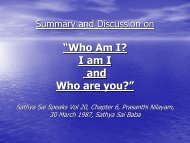Gyani Baile & Dolly Baile
Gyani Baile & Dolly Baile
Gyani Baile & Dolly Baile
You also want an ePaper? Increase the reach of your titles
YUMPU automatically turns print PDFs into web optimized ePapers that Google loves.
shastra: the science of rituals and ceremonials in religious rites, and 6)<br />
Jyotish: the science of astronomy and astrology.<br />
The profound and complex philosophy of the Upanishads is simplified<br />
and composed in the form of parables and stories in the set of books called<br />
Ithihasa or Epics. There are total four epics 1) Ramayan, 2)<br />
Mahabharat, 3) Yogavashishta and 4) Harivamsa. Of these the<br />
Ramayan and Mahabharat are most commonly known and read. They<br />
teach the ideals of Hinduism in a simple way.<br />
There is another set of books called Puranas. There are total 18<br />
Puranas and 18 Upa Puranas. The three most popular Puranas are<br />
Bhagavata, Vishnu, and Markandeya purana. The Puranas are not<br />
meant for the intellectuals, or spiritually advanced but they do convey the<br />
truths of the Vedas and dharma shastras in the form of moral stories which<br />
are entertaining and educational. Through these stories are taught the<br />
fundamentals of spirituality like the importance or prayer and meditation,<br />
amazing results of devotion, virtue of generosity, adhering to truth etc. It<br />
is in Puranas, though, that one finds about the ten incarnations or Avatars<br />
of Lord Vishnu on earth namely in the form of Matsya (fish), Kurma<br />
(tortoise), Varaha (boar), Narasimha (half man half lion), Vamana<br />
(the dwarf), Parsurama (the angry man), Rama (the perfect man, the<br />
main character from epic Ramayan), Krishna divine statesman, the<br />
main charter of Bhagavad Gita and Mahabharat), and the Buddha (the<br />
compassionate man).<br />
Another type of scriptures, called Agamas, lay down the separate<br />
theological disciplines and doctrines for the worship of particular deities.<br />
Described in Agamas are three main sects Shaiva, Vaishnava, and<br />
Shakta. In Shaiva agama God worshipped in the form of Lord Shiva. In<br />
Vaishnava agama God is worshipped in the form of Vishnu. Shakta<br />
agama glorifies Devi, the consort of Shiva, as the World Mother and<br />
energy giving power behind creation, sustenance and destruction. Each<br />
Agama consists of three parts: 1) Philosophy and spiritual knowledge<br />
behind the worship of the deity, 2) Yoga and the mental discipline<br />
required for each school of philosophy, 3) rules for constructing<br />
temples.<br />
130



